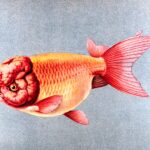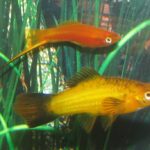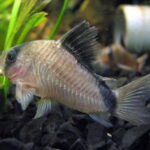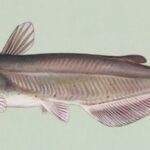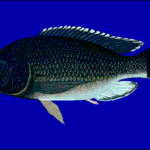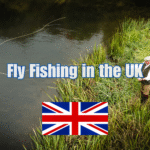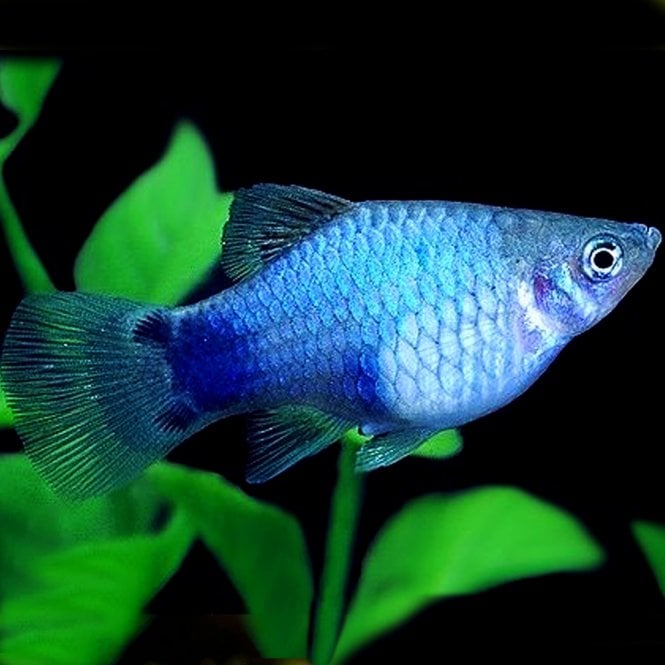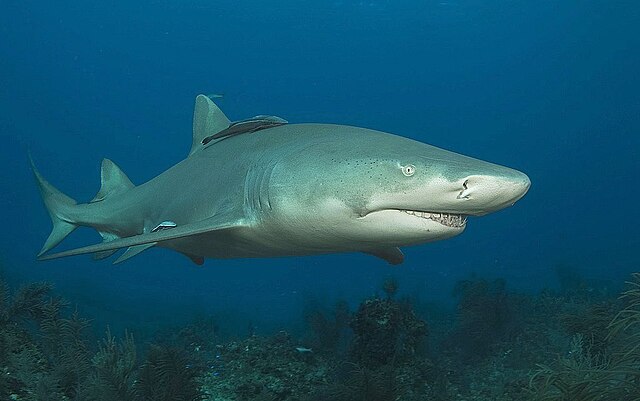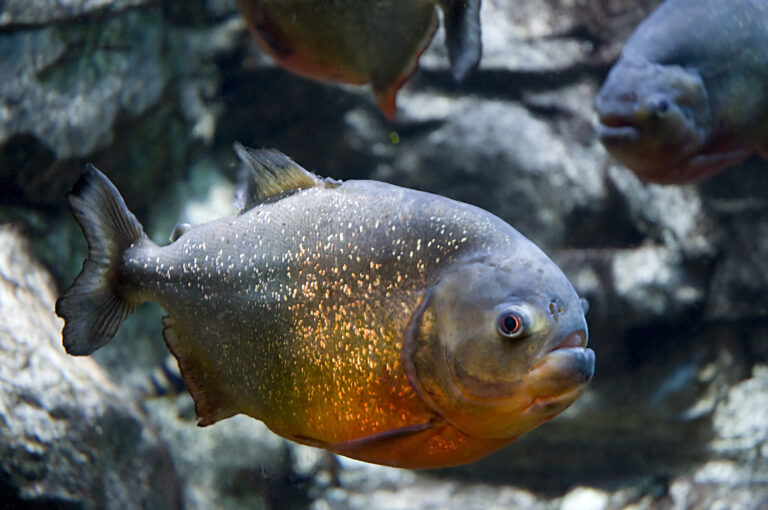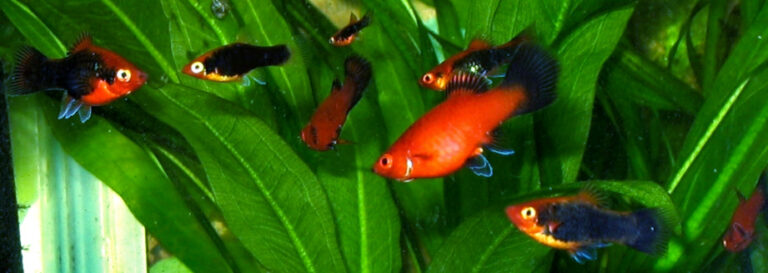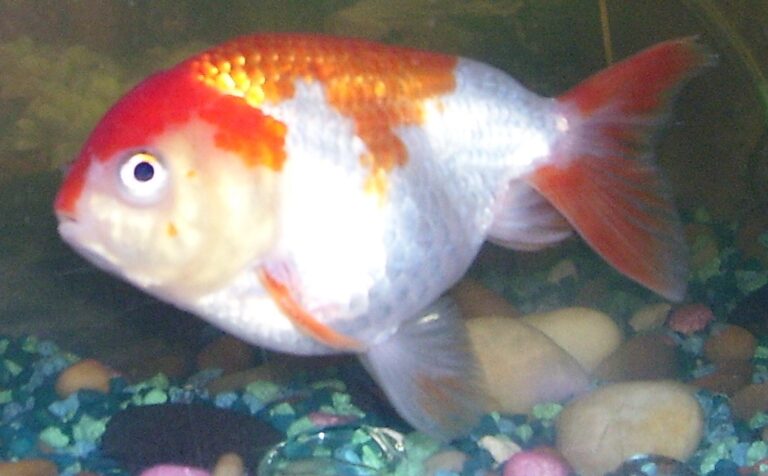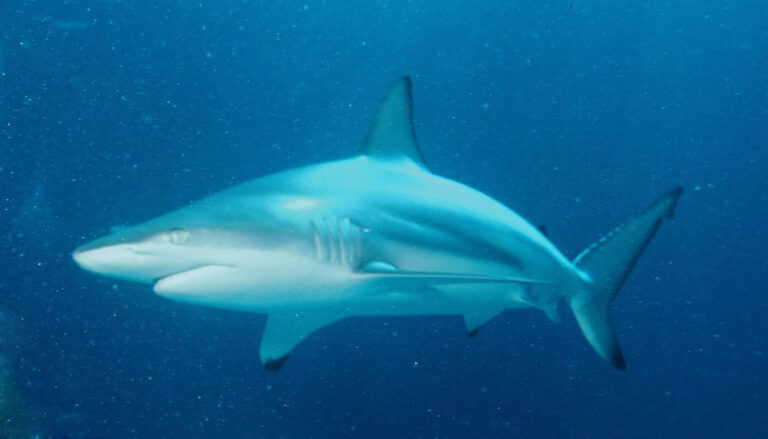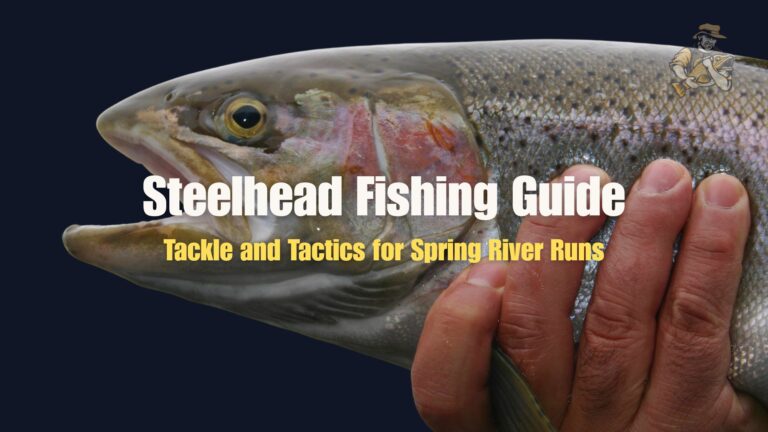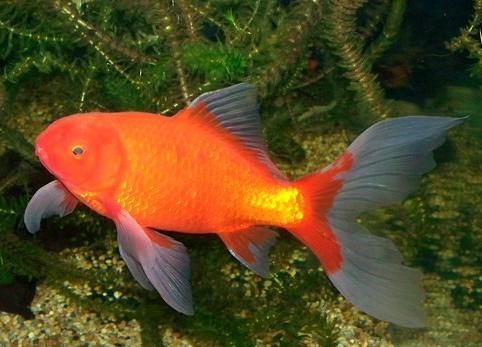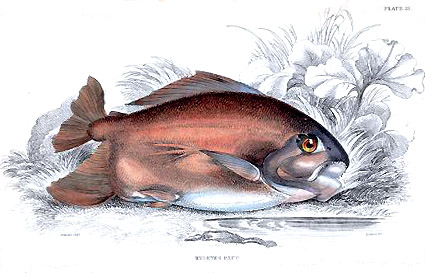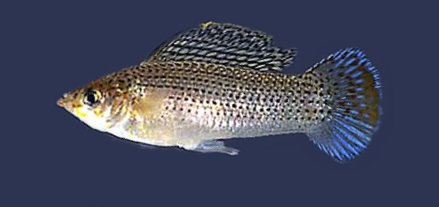Cherry Barb
By Ryan Maron | Last Modified: June 5, 2025
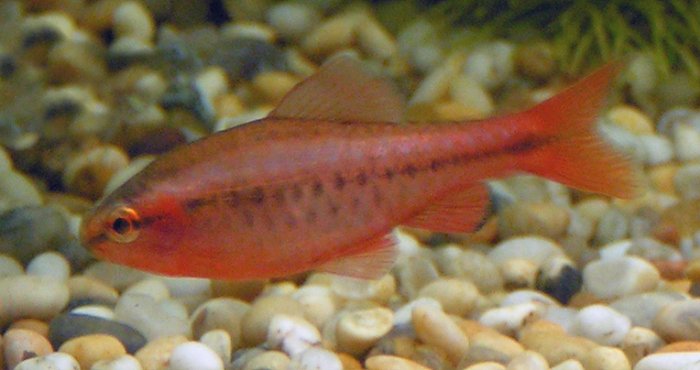
The Cherry Barb (*Puntius titteya*) stands as one of the most recognizable and ecologically significant small cyprinid species in Southeast Asian freshwater ecosystems. Native to the hill streams and tributaries of Sri Lanka, this vibrant schooling fish has captured the attention of aquarists and ichthyologists alike through its distinctive crimson coloration and remarkable adaptability to varying water conditions. Beyond its ornamental appeal, the Cherry Barb serves a crucial ecological function as both a primary consumer of aquatic invertebrates and a vital prey species for larger predatory fish within its native habitat.
The species demonstrates exceptional resilience in moderately acidic to neutral water systems, where it forms dynamic shoals that contribute significantly to nutrient cycling and energy transfer within stream ecosystems. Its widespread cultivation in the aquarium trade has provided valuable insights into cyprinid breeding behaviors and adaptation mechanisms, making it an important model species for understanding tropical freshwater fish ecology.
| Feature | Details |
| Common Name | Cherry Barb |
| Scientific Name | Puntius titteya |
| Family | Cyprinidae |
| Typical Size | 4-5 cm (1.6-2.0 inches), 2-4 grams |
| Habitat | Slow-moving streams and tributaries |
| Diet | Omnivorous – insects, algae, plant matter |
| Distribution | Sri Lanka (endemic) |
| Conservation Status | Vulnerable |
Taxonomy & Classification
The Cherry Barb belongs to the family Cyprinidae, one of the largest and most diverse fish families comprising over 3,000 species worldwide. Within this extensive family, *Puntius titteya* represents a distinct lineage of small-bodied barbs endemic to the island nation of Sri Lanka. The species was first scientifically described by Deraniyagala in 1929, establishing its taxonomic position within the genus *Puntius*, which encompasses numerous South and Southeast Asian cyprinid species.
Recent phylogenetic analyses have revealed that the Cherry Barb shares close evolutionary relationships with other Sri Lankan endemic barbs, including *Puntius cumingii* and *Puntius nigrofasciatus*. These species collectively form a monophyletic group that diverged from mainland Asian *Puntius* populations approximately 15-20 million years ago, coinciding with the geological separation of Sri Lanka from the Indian subcontinent.
The taxonomic classification of *Puntius titteya* has undergone several revisions as molecular techniques have refined our understanding of cyprinid relationships. Some authorities have proposed transferring the species to the genus *Puntigrus*, based on morphological and genetic evidence suggesting distinct evolutionary lineages within the traditional *Puntius* complex. However, the name *Puntius titteya* remains widely accepted in both scientific literature and aquarium trade contexts.
Physical Description
The Cherry Barb exhibits remarkable sexual dimorphism in both coloration and body structure, with mature specimens displaying distinct characteristics that facilitate identification and behavioral studies. Adult males typically reach 4-5 centimeters in total length, with females growing slightly larger at 5-6 centimeters. The species possesses an elongated, laterally compressed body typical of stream-dwelling cyprinids, optimized for navigating flowing water environments.
Male Cherry Barbs develop intense cherry-red to deep crimson coloration during breeding periods, particularly concentrated along the lateral stripe and ventral regions. This vibrant pigmentation results from specialized chromatophores containing astaxanthin and other carotenoid compounds, which intensify under optimal environmental conditions and proper nutrition. Females maintain more subdued coloration throughout their lifecycle, displaying golden-bronze hues with darker vertical banding patterns.
The species features a prominent black lateral stripe extending from the operculum to the caudal peduncle, which serves as a key diagnostic character distinguishing Cherry Barbs from related species. The dorsal fin contains 8-9 soft rays, while the anal fin typically has 5-6 rays. The caudal fin displays a distinctive forked shape with rounded lobes, facilitating efficient propulsion in slow to moderate current conditions.
Cherry Barbs possess small, subterminal mouths equipped with pharyngeal teeth arranged in a 5.3.2-2.3.5 pattern, typical of omnivorous cyprinids. These specialized teeth enable efficient processing of both plant material and small invertebrate prey. The eyes are proportionally large relative to head size, reflecting their adaptation to detecting food items and predators in vegetated aquatic environments.
Habitat & Distribution
The Cherry Barb maintains an extremely limited natural distribution, endemic exclusively to the Kelani and Nilwala River basins in southwestern Sri Lanka. This restricted range encompasses approximately 2,000 square kilometers of hill country terrain, characterized by moderate elevation gradients and consistent tropical rainfall patterns. The species inhabits slow-moving streams, tributaries, and backwater areas with soft substrates and abundant aquatic vegetation.
Natural Cherry Barb habitats typically feature water temperatures ranging from 22-26°C, with pH levels between 6.0-7.0 and moderate hardness values of 5-12 dGH. These parameters reflect the influence of lateritic soils and monsoon precipitation patterns characteristic of Sri Lankan hill regions. Stream systems supporting Cherry Barb populations often contain elevated levels of dissolved organic compounds from decomposing leaf litter and terrestrial vegetation.
The species demonstrates strong preferences for areas with moderate to dense aquatic plant coverage, particularly zones dominated by *Cryptocoryne* species, *Aponogeton* varieties, and submerged grasses. These vegetated microhabitats provide essential cover from predators, spawning substrates, and concentrated food resources in the form of epiphytic algae and associated invertebrate communities.
Human activities have significantly impacted Cherry Barb distribution patterns over the past century. Agricultural expansion, deforestation, and urban development have fragmented many stream systems, isolating populations and reducing available habitat. Water pollution from agricultural runoff and domestic waste has degraded water quality in several historically productive areas, contributing to local population declines.
Diet & Feeding Behavior
Cherry Barbs exhibit omnivorous feeding behavior with distinct preferences for small invertebrates, algae, and decomposing plant material. Wild populations consume a diverse array of prey items including chironomid larvae, small crustaceans, aquatic worms, and various microscopic organisms found among aquatic vegetation. Their feeding ecology plays a crucial role in controlling invertebrate populations and facilitating nutrient cycling within stream ecosystems.
The species demonstrates opportunistic foraging strategies, actively searching substrate surfaces and plant structures for available food sources throughout daylight hours. Peak feeding activity typically occurs during early morning and late afternoon periods when invertebrate prey density reaches maximum levels. Cherry Barbs employ both visual and chemical cues to locate food items, using their sensitive barbels to detect buried or concealed prey organisms.
Seasonal variations in diet composition reflect changing resource availability within their natural habitat. During monsoon periods, increased terrestrial input provides access to fallen insects, seeds, and organic debris that supplement their primarily aquatic diet. Dry season feeding focuses more heavily on periphyton, filamentous algae, and resident invertebrate populations that concentrate in remaining pool areas.
The species exhibits minimal dietary specialization compared to other cyprinid species, enabling successful colonization of varied microhabitats within their limited geographic range. This feeding flexibility has contributed significantly to their success in aquarium environments, where they readily accept commercial fish foods, live prey, and plant-based supplements. Understanding Cherry Barb feeding ecology provides valuable insights for both conservation efforts and aquaculture management practices.
Behavior & Adaptations
Cherry Barbs display complex schooling behaviors that serve multiple ecological and survival functions within their natural stream environments. Groups typically consist of 6-20 individuals organized in loose aggregations that maintain cohesion through visual and lateral line communication systems. These schools demonstrate dynamic leadership patterns, with different individuals taking directional roles based on environmental conditions and resource distribution.
The species exhibits distinct temporal activity patterns, with peak behavioral activity occurring during crepuscular periods when predation pressure is reduced and prey availability increases. During daylight hours, Cherry Barb schools often seek shelter among aquatic vegetation or under overhanging bank structures, emerging to forage in open water areas as light levels decrease.
Territorial behavior becomes pronounced during breeding periods, when mature males establish and defend small territories within preferred spawning areas. These territories typically encompass 0.5-1.0 square meters of substrate containing dense vegetation or other suitable spawning substrates. Males display intensified coloration and aggressive posturing to ward off competing individuals while attempting to attract gravid females.
Cherry Barbs have evolved several physiological adaptations enabling survival in their variable tropical stream environment. Their efficient gill structure facilitates oxygen extraction from water with fluctuating dissolved oxygen levels, while specialized swim bladder modifications enhance buoyancy control in flowing water conditions. The species demonstrates remarkable temperature tolerance, surviving seasonal variations of 6-8°C without significant physiological stress.
Social learning behaviors have been documented in Cherry Barb populations, with individuals demonstrating improved foraging efficiency and predator avoidance when maintained in established groups. This behavioral plasticity contributes to their success in both natural and artificial environments, making them valuable subjects for studies of fish cognition and social behavior.
Reproduction & Life Cycle
Cherry Barb reproduction follows seasonal patterns closely tied to monsoon cycles and associated changes in water temperature, flow rates, and food availability. Breeding activity peaks during the pre-monsoon period from April to June, when stable water conditions and abundant food resources create optimal conditions for spawning and larval development.
Sexual maturity occurs at approximately 6-8 months of age, corresponding to standard lengths of 3-4 centimeters. Mature females develop noticeably fuller bodies due to developing egg masses, while males display intensified coloration and more pointed dorsal and anal fins. Breeding readiness can be assessed through these external morphological changes and behavioral indicators.
Spawning behavior involves elaborate courtship rituals initiated by territorial males within established breeding areas. Males perform distinctive swimming patterns, displaying bright coloration while attempting to guide receptive females toward suitable spawning substrates. Preferred spawning sites typically feature fine-leaved aquatic plants or artificial spawning media in aquarium settings.
Female Cherry Barbs deposit 200-300 adhesive eggs over multiple spawning events, scattering them among vegetation or suitable substrates. The eggs measure approximately 1.0-1.2 millimeters in diameter and require 24-36 hours for hatching under optimal temperature conditions of 26-28°C. Newly hatched larvae possess large yolk sacs that sustain them for 3-4 days before active feeding begins.
Larval development progresses rapidly under favorable conditions, with fry reaching free-swimming stage within one week of hatching. Initial growth rates depend heavily on water quality, temperature stability, and food availability. Young Cherry Barbs begin exhibiting schooling behavior at approximately 2-3 weeks of age, gradually developing adult coloration patterns over subsequent months.
Parental care behavior is absent in Cherry Barbs, with adults showing no protective behavior toward eggs or fry. This reproductive strategy reflects adaptation to environments where parental investment would provide minimal survival advantages due to high predation pressure and resource competition.
Predators & Threats
Cherry Barbs face predation pressure from numerous aquatic and semi-aquatic predators throughout their natural range in Sri Lankan stream systems. Primary predators include larger cyprinid species such as *Tor khudree* and *Labeo rohita*, which actively hunt Cherry Barb schools in open water areas. Native catfish species, particularly *Mystus* varieties, pose significant threats during nighttime hours when Cherry Barbs seek shelter in vegetation.
Avian predation represents another major mortality factor, with several kingfisher species, herons, and egrets regularly feeding on Cherry Barb populations in shallow stream areas. The White-throated Kingfisher (*Halcyon smyrnensis*) and Common Kingfisher (*Alcedo atthis*) demonstrate particular efficiency at capturing Cherry Barbs during their foraging activities.
Introduced predator species have created additional pressures on native Cherry Barb populations throughout their limited range. Non-native fish such as *Oreochromis* tilapia species and various *Trichogaster* gouramis compete for resources while occasionally preying on juvenile Cherry Barbs. These introductions have altered predator-prey dynamics in many stream systems, contributing to population declines.
Habitat degradation represents the most significant long-term threat to Cherry Barb survival in wild populations. Deforestation activities within watershed areas have increased sedimentation rates, reducing water quality and eliminating crucial spawning habitats. Agricultural expansion has introduced pesticides and fertilizers into stream systems, creating toxic conditions that affect both Cherry Barbs and their food sources.
Water extraction for irrigation and domestic use has reduced flow rates in many streams, concentrating pollutants and increasing predation vulnerability. Climate change impacts, including altered precipitation patterns and increased temperature extremes, pose emerging threats to the species’ limited habitat range. These combined pressures have resulted in significant population fragmentation and local extinctions in several historically productive areas.
Conservation Status
The International Union for Conservation of Nature (IUCN) currently classifies the Cherry Barb as Vulnerable, reflecting significant concerns about population trends and habitat degradation throughout its extremely limited natural range. This conservation status was assigned based on documented population declines exceeding 30% over the past decade, coupled with continuing habitat loss and fragmentation within Sri Lankan endemic fish communities.
Population monitoring efforts conducted by Sri Lankan fisheries authorities have documented concerning trends in Cherry Barb abundance across multiple stream systems. Several tributaries that historically supported substantial populations now show severely reduced densities or complete local extinctions. These declines correlate directly with increased human activities within watershed areas and degraded water quality conditions.
The species’ restricted distribution represents a critical vulnerability factor, with the entire natural population confined to less than 2,000 square kilometers of suitable habitat. This limited range makes Cherry Barb populations particularly susceptible to catastrophic events, disease outbreaks, or continued habitat degradation that could affect multiple populations simultaneously.
Conservation efforts currently focus on habitat protection and restoration initiatives within key watershed areas. The Sri Lankan Department of Wildlife Conservation has established several protected zones encompassing critical Cherry Barb habitats, restricting development activities and implementing water quality monitoring programs. These protected areas represent approximately 15% of the species’ historical range.
Ex-situ conservation programs have been established at several research institutions and aquarium facilities worldwide, maintaining genetically diverse breeding populations that could support reintroduction efforts if wild populations continue declining. The widespread availability of Cherry Barbs in the international aquarium trade provides an important conservation safety net, though genetic diversity concerns exist regarding commercially bred populations.
International cooperation through the Convention on International Trade in Endangered Species (CITES) may become necessary if population declines continue at current rates. Such listing would regulate international trade and provide additional resources for conservation research and habitat protection initiatives.
Human Interaction
Cherry Barbs have maintained significant cultural and economic importance within Sri Lankan communities for generations, serving both as subsistence food sources and ornamental aquarium specimens. Local fishing communities traditionally harvested Cherry Barbs using small-mesh nets and traps, though this practice has declined substantially due to reduced wild populations and economic alternatives.
The international aquarium trade represents the most significant form of human interaction with Cherry Barb populations today. Commercial breeding operations, primarily located in Southeast Asian countries, produce millions of specimens annually for global distribution. These aquaculture facilities have developed sophisticated breeding protocols that maintain genetic diversity while meeting market demand for high-quality ornamental fish.
Aquarium hobbyists worldwide appreciate Cherry Barbs for their peaceful temperament, vibrant coloration, and relatively simple care requirements. The species has become a cornerstone species in community aquarium setups, often serving as an introduction to cyprinid keeping for novice aquarists. This popularity has driven extensive research into optimal husbandry practices and breeding techniques.
Scientific research applications have utilized Cherry Barbs as model organisms for studies of tropical fish physiology, behavior, and reproduction. Their adaptability to laboratory conditions and well-documented life history characteristics make them valuable subjects for comparative ichthyology research. Several universities maintain Cherry Barb colonies specifically for educational and research purposes.
Conservation education programs in Sri Lanka increasingly feature Cherry Barbs as flagship species for endemic freshwater fish conservation. School programs and community outreach initiatives use the species’ appealing appearance and conservation status to raise awareness about freshwater ecosystem protection and sustainable resource management practices.
The development of sustainable aquaculture techniques for Cherry Barb production has created economic opportunities for rural communities while reducing pressure on wild populations. Training programs supported by international development organizations have established small-scale breeding operations that provide income while supporting conservation goals.
Interesting Facts
Cherry Barbs possess remarkable color-changing abilities that extend beyond simple breeding coloration changes. Individuals can rapidly adjust their pigmentation in response to social status, environmental conditions, and stress levels. Dominant males display the most intense red coloration, while subordinate individuals adopt more subdued tones to avoid aggressive encounters.
The species demonstrates exceptional longevity for a small cyprinid, with properly maintained aquarium specimens living 4-7 years. Wild populations may achieve even greater longevity due to natural dietary diversity and exercise levels, though predation pressure typically limits individual survival times in natural environments.
Cherry Barbs exhibit sophisticated memory capabilities, remembering feeding locations, shelter sites, and potential danger areas for extended periods. Research studies have documented spatial memory retention exceeding 30 days, suggesting complex cognitive abilities that facilitate survival in variable stream environments.
Temperature tolerance ranges of Cherry Barbs exceed those of most tropical fish species, with individuals surviving temperatures as low as 18°C and as high as 32°C for short periods. This thermal tolerance reflects adaptation to seasonal temperature variations in their highland stream habitats and contributes to their success in diverse aquarium conditions.
The species plays an important role in traditional Sri Lankan medicine, with various parts used in folk remedies for digestive ailments and fever reduction. While scientific evidence for these applications remains limited, the cultural significance demonstrates the deep historical connections between Cherry Barbs and human communities.
Cherry Barbs can recognize individual conspecifics within their social groups, maintaining stable dominance hierarchies and partnership relationships over extended periods. This social recognition ability facilitates complex group behaviors and reduces energy expenditure from repeated aggressive encounters.
Unique among many cyprinid species, Cherry Barbs show minimal cannibalistic behavior toward their own eggs and fry, making them relatively easy to breed in captive conditions. This characteristic has contributed significantly to their success in commercial aquaculture operations and home breeding programs.
Frequently Asked Questions
What water conditions do Cherry Barbs require in aquariums?
Cherry Barbs thrive in water temperatures between 22-26°C with pH levels of 6.0-7.5 and moderate hardness of 5-15 dGH. They prefer well-oxygenated water with gentle filtration and regular water changes. Stable water parameters are more important than exact values, as the species demonstrates good adaptability to various conditions within reasonable ranges.
How can you distinguish male and female Cherry Barbs?
Male Cherry Barbs display intense red to cherry-red coloration, particularly during breeding periods, with more streamlined bodies and pointed fins. Females appear larger and rounder with golden-bronze coloration and less vibrant red tones. Males also exhibit more territorial and active behavior, especially when establishing breeding territories.
Are Cherry Barbs suitable for community aquariums?
Cherry Barbs make excellent community aquarium inhabitants due to their peaceful temperament and schooling behavior. They coexist well with other non-aggressive species of similar size, including various tetra species and other small cyprinids. Groups of 6-8 individuals display the most natural behaviors and reduced stress levels.
What do Cherry Barbs eat in captivity?
Captive Cherry Barbs accept a varied diet including high-quality flake foods, small pellets, frozen bloodworms, brine shrimp, and vegetable matter. They benefit from multiple small feedings daily rather than single large meals. Supplementing with live or frozen foods enhances coloration and breeding readiness, while blanched vegetables provide essential plant nutrients.
Conclusion
The Cherry Barb represents both the beauty and fragility of Sri Lanka’s endemic freshwater fish fauna, serving as a critical indicator species for the health of island stream ecosystems. While their popularity in the aquarium trade has ensured genetic preservation through captive breeding programs, wild populations face mounting pressures from habitat degradation and human development activities. Continued conservation efforts focusing on watershed protection and sustainable aquaculture development will be essential for ensuring the long-term survival of this remarkable cyprinid species in its natural environment.
Share The Article:
More Fish Species:
-
Blue Platy
The Blue Platy (Xiphophorus maculatus) stands as one of the most recognizable and culturally significant freshwater fish species in…
-
Lemon Shark
The Lemon Shark (*Negaprion brevirostris*) represents one of the most scientifically studied and ecologically significant predators in coastal marine…
-
Red Belly Piranha
The Red Belly Piranha (*Pygocentrus nattereri*) stands as one of South America’s most misunderstood freshwater predators, wielding razor-sharp teeth…
-
Southern Platyfish
The Southern Platyfish, scientifically known as *Xiphophorus maculatus*, represents one of the most significant freshwater fish species in both…
-
Lionhead Goldfish
The Lionhead Goldfish represents one of the most distinctive and cherished ornamental varieties within the goldfish family, captivating aquarists…
-
Bleeding Heart Tetra
The Bleeding Heart Tetra represents one of the most distinctive and peaceful freshwater fish species in the aquarium trade,…
Discover
-
New York Fishing License: Costs, Types & Where to Buy in 2025
Figuring out fishing licenses can be a headache, especially when you’re just eager to get out on the water….
-
Basking Shark
The Basking Shark stands as one of the ocean’s most magnificent gentle giants, representing the second-largest fish species on…
-
Blacktip Shark
The Blacktip Shark (Carcharhinus limbatus) stands as one of the most recognizable and ecologically significant predators in tropical and…
-
Tiger Shark
The Tiger Shark (Galeocerdo cuvier) represents one of the ocean’s most formidable apex predators, earning its distinctive name from…
-
Reading Water Temperature: Seasonal Cues for Better Fishing
I’ve spent more mornings than I can count staring at a thermometer clipped to my fishing line, watching those…
-
Steelhead Fishing Guide: Tackle and Tactics for Spring River Runs
There’s something almost magical about standing waist-deep in a frigid spring river, feeling the current push against your legs…
Discover
-
Bass Fishing Techniques: Expert Tips That Actually Work
Bass fishing has been my passion for over three decades, and if there’s one thing I’ve learned, it’s that…
-
Comet Goldfish
The Comet Goldfish (Carassius auratus) stands as one of the most recognizable and widely distributed freshwater fish species in…
-
Pacu Fish
Pacu fish represent one of South America’s most ecologically significant freshwater species, encompassing several closely related members of the…
-
Balloon Molly
The Balloon Molly (*Poecilia latipinna* var.) represents one of the most distinctive and popular ornamental fish varieties in the…
-
Black Molly
The Black Molly represents one of the most recognizable and enduring species in the freshwater aquarium trade, captivating both…
-
Pennsylvania Fishing License: Complete Guide for Anglers in 2025
Getting your Pennsylvania fishing license sorted isn’t exactly the most exciting part of fishing, but it’s absolutely necessary if…


